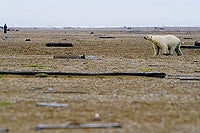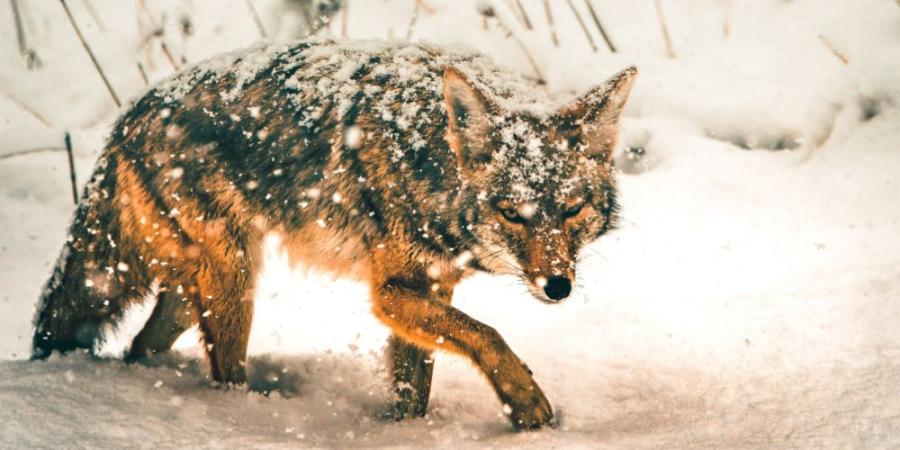In most quarters, the US government decision to list the polar bear as a threatened species was heralded as a milestone in awareness of global warming, but the people you might expect to most rejoice in the decision—the Arctic indigenous peoples who suffer the greatest effects of global warming—are strongly opposed to it.
 Polar Bear: A polar bear outside Barrow, Alaska. Photo by Gary BraaschAs the thin end of the global warming wedge begins prying apart the foundations of traditional life in the Alaskan Arctic, you might think that the native people there would welcome the federal listing of the polar bear as a threatened species. After all, everyone loves polar bears (Knud, the Berlin Zoo’s über-cute furball, appeared on the cover of the May 2007 Vanity Fair, photographed by none other than Annie Leibovitz), and they bring tourism dollars to the Arctic, raising awareness of global warming at the same time. But the Iñupiat—the indigenous people around Barrow, for whom the bears are a cornerstone of their traditional hunting culture, along with whales, seals and caribou—argue that listing the polar bear as threatened won’t save it. And as I explored the polar bear’s frozen-sea habitat on the north coast of Alaska in the winter of 2007, I came to understand their point of view.
Polar Bear: A polar bear outside Barrow, Alaska. Photo by Gary BraaschAs the thin end of the global warming wedge begins prying apart the foundations of traditional life in the Alaskan Arctic, you might think that the native people there would welcome the federal listing of the polar bear as a threatened species. After all, everyone loves polar bears (Knud, the Berlin Zoo’s über-cute furball, appeared on the cover of the May 2007 Vanity Fair, photographed by none other than Annie Leibovitz), and they bring tourism dollars to the Arctic, raising awareness of global warming at the same time. But the Iñupiat—the indigenous people around Barrow, for whom the bears are a cornerstone of their traditional hunting culture, along with whales, seals and caribou—argue that listing the polar bear as threatened won’t save it. And as I explored the polar bear’s frozen-sea habitat on the north coast of Alaska in the winter of 2007, I came to understand their point of view.
Dragging my supply sled toward my base in Barrow one frigid morning—it had been 30 below the night before, and I didn’t dare to check the temperature before I crawled out of my sleeping bag—I recalled the simple wonders of the past week. I’d heard the Arctic described as a wasteland, but nobody who’d taken the time to walk here could call it anything less than a thriving ecosystem. Cold, yes, but without question thriving, electric with life. I wanted to learn what native people thought about what was being done to protect this priceless wilderness in the face of increasing oil and gas exploration, and I thought the proposed listing of the polar bear as a threatened species might help smooth the way.
But Billy Leavitt, an Iñupiat hunter who picked me up on the outskirts of Barrow, blew that idea to pieces with a few words. As we tore down an ice road in his battered pickup truck, and a 60-below windchill blew through an open window—just about killing me but cooling him nicely—Billy gestured at the landscape, speaking in long, flat vowels and drawn-out consonants.
“It’s too warm for this time of year,” he said, “That global warming is really happening.”
“Yeah, I hear the polar bear is in trouble,” I replied, trying to sympathize. Billy tensed up.
“No,” he said, “That’s your Greenpeace people sayin’ that. That’s your conservationists,”—he spat the last word—“people who watch that Discovery Channel and then come up here to tell us how to hunt.” I considered myself a conservationist, but I had no reply to that conversation-stopper. I sat there wondering what else I might be wrong about.
Still, Billy cordially shook my hand when he dropped me off in Barrow, inviting me to come to his cabin out on the land. “You’ll learn a lot,” he said. Although I didn’t have a chance to visit him, I did take another trek, and learned a little more about his point of view. On March 7th, the residents of Barrow (over 60 percent Iñupiat) met with representatives of the U.S. Fish and Wildlife Service, the federal agency then considering listing the polar bear as threatened.
The Iñupiat Heritage Center, where the meeting was held, is a modern, multi-million-dollar facility at once a museum displaying relics of pre-contact life, a meeting hall, and a work area where walrus-hide boats are sewn together in preparation for whale-hunts. Once everyone’s snowmobiles had been parked it was quiet in the meeting hall, but the atmosphere was tense. A handful of Fish and Wildlife presenters sat at a table in the front of the hall, looking out at a hundred mostly native Barrow residents, who awaited the government’s presentation with patience, but no smiles.
The meeting began with the government representatives presenting their case for listing the polar bear, supported by two main points. First, the polar bear’s sea ice habitat has been steadily reduced in the past 30 years, a finding of 5 independent studies that nobody can deny: today, satellite imagery shows us an Alaska-sized hole in the summer sea ice cover, where 30 years ago it was a solid sheet, and the prediction is that by 2050, most of the Arctic Ocean will be ice-free in the summer, driving polar bears either to adapt to land in that season, or go extinct. The Iñupiat agreed with this, saying in fact that they’d been trying to raise the alarm over global warming for years. Still, they let this point slide.
Second, Fish and Wildlife argued that polar bear populations are already in decline, as seen in a study of the western Hudson Bay polar bear population, which they claimed has decreased by over 20 percent in the last 20 years. The Iñupiat weren’t so sure of this; like their Canadian counterparts, the Inuit, they believed that polar bear numbers were actually up, but that the bears had migrated out of the scientists’ survey areas. Still, Fish and Wildlife concluded that while over-hunting, disease, and other factors do not threaten the polar bear throughout its natural range, it should be listed as threatened because of the well-documented decline of sea ice.
Then the Iñupiat took the podium. For two hours they presented their own testimony, questioning Fish and Wildlife’s assumptions and facts, and making a strong case for entrusting the survival of the polar bear not to regulations dictated from Washington, D.C., but to the Iñupiat and other native polar people.
It’s not surprising that the Iñupiat’s discussion of polar bear biology, behavior, ecology, habitat, and population was more sophisticated than that of the Fish and Wildlife representatives; after all, the federal representatives had flown in from Washington or Anchorage, and would fly out in a day or two, while the Iñupiat lived their entire lives in the polar bear’s habitat. They were not new to the polar bear, and they weren’t impressed by 30-year studies that Fish and Wildlife called “long-term.” The Iñupiat had cultural knowledge about polar bears—and the rest of their ecosystem—that went back far longer. “As the ice retreats,” one hunter said, “some bears will follow it, and others will get stranded on land, like some of them are now, when the ice retreats in the summer. Those that follow the ice will survive, and those that live on the land will have to adapt, just like their ancestors did.” Glenn Sheehan, executive director of the Barrow Arctic Science Consortium, pointed out that the polar bear had been living with climate changes for more than 200,000 years, and that it had survived at least one other warming episode, the Medieval Warm period. “Have you considered that at all?” he asked the Fish and Wildlife representatives. “Do you even have data going back more than 50 years?”
The Iñupiat speakers included common citizens, native hunters, several whaling captains, and North Slope Borough mayor Edward S. Itta, all of whom looked hard into the eyes of the Fish and Wildlife representatives. After all, in this modest meeting they were doing nothing less than fighting to prevent yet another important part of their traditional life from being wrested away from them by a distant federal agency.
The Iñupiat based their opposition to polar bear listing on three main facts. First, in their experience polar bear numbers were not declining, an observation also noted by native Canadians on Hudson Bay, who say the decline there has been misunderstood by scientists who drop in from time to time, but fail to understand polar bear migration behavior. One resident pointed out that scientists were fond of saying they needed “holistic, long-term studies” of the polar bear, but were—insultingly and stupidly—ignoring exactly that kind of knowledge by relying on studies that “only went back a generation or two.” Mayor Itta sharply pointed out that the Fish and Wildlife study did not actually have empirical data for the population increase or decrease of polar bears in northern Alaska, only projections and estimates based on the Hudson Bay population, 4,000 miles away. If the tables were turned, Itta noted, Washington wouldn’t respond to hypotheses or hearsay; they’d want real, empirical data, and the Iñupiat deserved the same. In short, Fish and Wildlife’s data on the polar bear population was largely theoretical (they had admitted this in their own presentation), and based on no more empirical facts or observations than the Iñupiats’ own. The implication was clear to all: who would you rather trust about these numbers—the people who live in the area and observe the polar bear population day by day, or federal government monitors?
The Iñupiats’ second point was that they simply don’t take enough bears to threaten the species, only about 20 a year. Indeed, Fish and Wildlife’s own study concluded that over-hunting was not a threat in Canada (because of sound management policies there) or Alaska (because of the 30-year old Marine Mammal Protection Act). Barrow Arctic Science Consortium president and native hunter Richard Glenn told Fish and Wildlife, “If you want to address over-hunting, go to Russia, where they poach 200 polar bears a year!”
The third point, mentioned time and again, was summarized by Mayor Itta: “Listing the polar bear does not address the problem!” Whaling captain Charlie Brower said, “The problem—pointed out in your own study—is shrinking sea ice, which is caused by carbon dioxide emissions!” The Iñupiat said that listing the polar bear as threatened does nothing to address sea ice retreat; it’s just a measure meant to make people of the Lower 48 feel as though they’re “saving the polar bear” when in fact they’re doing nothing at all.
Listing a species as threatened or endangered is meant to force federally backed action to preserve that species’ critical habitat. If that habitat isn’t delineated, however, the listing has little value. In this case, the Fish and Wildlife Department found that the bears’ habitat needs were “undeterminable.” The proposed listing did not mention greenhouse gas or carbon emissions at all, an omission that was made overt when Secretary of the Interior Dirk Kempthorne announced the official threatened listing for polar bears on May 18, 2008. “The most significant part of today’s decision,” he said, “is what President Bush observed about climate change policy last month. President Bush noted that ‘The Clean Air Act, the Endangered Species Act and the National Environmental Policy Act were never meant to regulate global climate change.’”
If the polar bear’s critical sea ice habitat isn’t defined, the Iñupiat argued, and its reduction isn’t linked to human-induced warming brought about by greenhouse gas emissions, then listing the polar bear will not work as a lever to force action on climate change.
In short, the science brought by the Fish and Wildlife representatives to justify listing the polar bear as threatened looked great on paper, but was incomplete—even to other scientists—and ignored Iñupiat traditional knowledge. And putting the polar bear on the endangered list wouldn’t stop illegal poaching in Russia, or the sea ice from retreating, or anything else that was actually affecting polar bear populations. In fact it would mask the real issue of climate change.
The Iñupiat solution was for Washington to address climate change head-on by legislating global-warming preventatives, and leave the polar bears to the native peoples of the Arctic. After all, they are subsistence hunters who manage animal populations so that they will be there in the future. The word “sustainable” has been in the American consciousness for about a generation, while it has been the cornerstone of Iñupiat life for millennia. Not taking their lead in this issue would be a terrible loss of opportunity, especially considering that they are living on the front line of global warming, where change is felt first and foremost.
Dr. Cameron M. Smith, an archaeologist at Portland State University’s Department of Anthropology, has recently published The Top Ten Myths About Evolution (Prometheus, 2006) and has written articles for Scientific American MIND, Archaeology, Spaceflight, Playboy and other magazines. He returned to north Alaska in February 2008.



